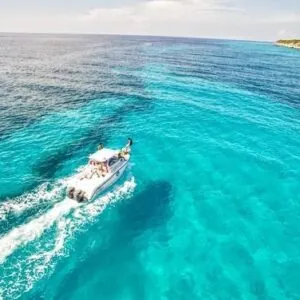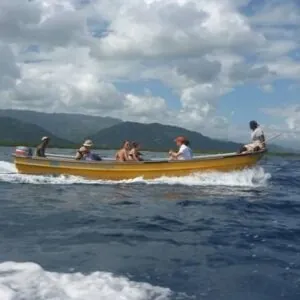While decades of political instability and a series of natural disasters have plagued the country, which shares the island of Hispaniola with the Dominican Republic, Haiti is slowly bouncing back. And despite it being one of the lesser-known diving destinations in the Caribbean, there are plenty of great sites for divers of all levels, not to mention exciting experiences for visitors above sea level, too. Travelers will enjoy discovering Haiti’s vibrant art scene, exciting fusion cuisine and ever-present musical vibes. Then, of course, there are the gorgeous beaches (including many that haven’t been over-developed by big-name resorts) and lapping crystal-clear waters so typical of the Caribbean. But because Haiti isn’t a popular dive destination, be sure to book your dive in advance in order to avoid disappointment.
GETTING THERE
-
Haiti is a Caribbean country, meaning U.S. citizens require a passport to travel there. See TSA requirements for the most up to date information.
-
The main airports in Haiti are Toussaint Louverture International Airport (PAP) near Port-au-Prince and Cap-Haitien International Airport (CAP) in northern Haiti.
-
In general, road quality is poor here so visitors may want to think twice before hiring a car. Instead, opt for the collective taxis called publiques for getting around Port-au-Prince and Cap-Haïtien. You can also jump on a bus or a taptap (brightly-colored converted pick-ups) if you don’t mind squeezing in.
GOOD TO KNOW
-
Haiti is a Central American country.
-
TIME ZONE: Central Standard Time.
-
PRIMARY LANGUAGE: Spanish.
-
CURRENCY: the colón (plural: colones). U.S. dollars are accepted in many tourist areas.
-
PHONE AND INTERNET: Phone service is available from most U.S. phone carriers (you may need to activate international roaming). Internet is readily available including Wi-Fi at hotels and restaurants. The international calling code is +509.
-
VOLTAGE: 110 (the U.S. and Canada use 120 V so converters or adapters are typically not needed).
-
The rainy season runs from April through October and the hurricane season runs from June to November.
-
There is currently a level 3 travel advisory (reconsider travel) in effect for Haiti. Visit travel.state.gov for more information.
DIVE CONDITIONS
-
Water temperatures range from 80 degrees Fahrenheit in winter to 85 degrees in summer.
-
WHEN TO GO
-
Scuba diving in Haiti is available all year-round.
-
The peak season for tourism is late November to March.
-
WHAT YOU’LL SEE
-
Haiti’s history of overfishing means that marine life is not as plentiful here as other spots in the Caribbean, although measures are being taken to create designated protected areas and there’s hope that things will continue to improve. Fortunately, there’s an abundance of healthy corals and sponges, including some of the largest elephant ear sponges in the world. Divers can also expect to see moray eels, crabs and the occasional stingray, barracuda or reef shark.
BEST SCUBA DIVING SITES IN HAITI
AMANI’S ZOMBIE HOLE
The most famous diving site in Haiti, Armani’s Zombie Hole, is located near St. Marc. This thrilling dive extends to a depth of 450 feet and boasts mind-boggling black coral and sponge tubes. The largest elephant ear sponge in the world was said to be found here around 130 feet below but hasn’t been seen in a while, leading some to think that it was pushed over the edge in a storm. Experienced divers will also encounter blue tang, sea urchins and nearby, the alleged remains of the Mary Celeste shipwreck which sank in 1884.
KALIKO
Just off of Kaliko beach lies a small PT at a depth of about 90 feet. The wreck neighbors a deep wall giving divers the opportunity to combine two interesting sites in one. Two larger boats, the Tina D and the Ellie Jeanne, lie deeper and are better suited for more advanced divers.
ARCADINS ISLANDS
These three small cays located about 5 miles west of the mainland feature good visibility and a variety of coral and colorful fish life. Great for divers of all levels.
BIZOTON
Although water quality in Bizoton in the Bay of Port-au-Prince isn’t great (pollution is rife), wreck divers might enjoy exploring The Seasprite, a ferry that sank in the late 1990s. Here, you’ll also encounter groupers, snappers, moon jellies, urchins and oysters.
BEST SNORKELING IN HAITI
There are some gorgeous snorkeling sites in Haiti but you might want to enlist the help of a tour guide in order to find them. Popular sites include Bas Limbe and Labadee in the northern part of the country and Les Cayes and Jacmel in the south.
DISCOVER UNIQUE THINGS TO DO IN HAITI
LA CITADELLE AND PALAIS SANS SOUCI
The Citadelle la Ferrière is an impressive fortress perched high on top of a mountain that overlooks the jungle and farm fields below (you’ll need to hike or ride a horse to get up there). At its foot sit the ruins of Sans Souci palace built by the former slave turned revolutionary leader and king Henry Christophe. Together they make up Haiti’s only UNESCO World Heritage site and are definitely worth a visit.
RUM FACTORIES
You can’t go to Haiti without sampling some of the local rum and touring one of the island’s rum factories is an excellent way to do it. The Barbancourt Distillery is one of the most popular spots.
BASSIN BLEU
You’ll find this secluded swimming hole situated on the hills of Jacmel (enlist the help of a local guide to get there). Float around in one of the three azure pools or make like the local kids do and jump from the waterfalls—either way, you’ll feel utterly relaxed by the time you leave.









